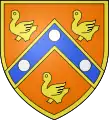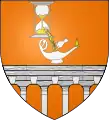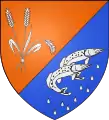
In heraldry, orange is a tincture, rarely used other than in Catalan, South African, French municipal and American military heraldry. As a colour, Orange should be used against metals in order not to contravene the rule of tincture. Orange is distinct not only from Gules (red), but also from Tenné (or Tanné), which originated as the light-brownish colour of tanned leather, and from Carnation, used for the depiction of white human skin.
Orange was not allocated a pattern in the system of hatching developed in the early 17th century, but later received one in the form of a series of vertical lines of dots and dashes (a hybrid of the vertical lines used to represent Gules, and the dots used to represent Or).[1]
The orange colour used in heraldry should be rich and deep enough to be clearly distinguished from both metals, Argent (white) and Or (yellow), and from Gules (red), Tenné (light brown) and Carnation (flesh-colour).
Gallery
 Arms of commune Lamorlaye, France.
Arms of commune Lamorlaye, France. Coat of arms of the Lagouanelle-Dély family.
Coat of arms of the Lagouanelle-Dély family..svg.png.webp) Arms of the commune Tavel, Gard, France.
Arms of the commune Tavel, Gard, France. Arms of the commune Monchy-sur-Eu, France.
Arms of the commune Monchy-sur-Eu, France. Arms of the commune Margny-les-Compiègne, France
Arms of the commune Margny-les-Compiègne, France Arms of Bellefontaine, France.
Arms of Bellefontaine, France..svg.png.webp) Arms of Le Sap, France
Arms of Le Sap, France.svg.png.webp) Arms of Brullioles, Rhône, France.
Arms of Brullioles, Rhône, France. Coat of arms of Armenia, bearing an escutcheon orange overall.
Coat of arms of Armenia, bearing an escutcheon orange overall..svg.png.webp) Arms of Saint-Honoré, Québec.
Arms of Saint-Honoré, Québec. Arms of Anthy-sur-Léman, French Savoy.
Arms of Anthy-sur-Léman, French Savoy..svg.png.webp) Arms of Hugleville-en-Caux, Normandy, featuring a leaf orange.
Arms of Hugleville-en-Caux, Normandy, featuring a leaf orange..svg.png.webp) Arms of Saint-Martin-du-Manoir, Normandy.
Arms of Saint-Martin-du-Manoir, Normandy..svg.png.webp) Coat of arms of La Chapelle-du-Bois-des-Faulx, Eure, featuring an orange flower.
Coat of arms of La Chapelle-du-Bois-des-Faulx, Eure, featuring an orange flower..svg.png.webp) Arms of Sorquainville, Normandy, featuring a cow argent with spots orange.
Arms of Sorquainville, Normandy, featuring a cow argent with spots orange..svg.png.webp) Faultive arms of Andelu, Yvelines, France, featuring a roundel orange.
Faultive arms of Andelu, Yvelines, France, featuring a roundel orange..svg.png.webp) Arms of Camps-la-Source, Provence, featuring the Cross orange on the lilies of France.
Arms of Camps-la-Source, Provence, featuring the Cross orange on the lilies of France..svg.png.webp) Arms of Coutarnoux, Burgundy, featuring a castle orange.
Arms of Coutarnoux, Burgundy, featuring a castle orange..svg.png.webp) Arms of Lichères-près-Aigremont, in Burgundy
Arms of Lichères-près-Aigremont, in Burgundy
References
- ↑ Fox-Davies, A. C. (1969) [1909]. Brooke-Little, J. P. (ed.). A Complete Guide to Heraldry. London: Thomas Nelson. pp. 60–61.